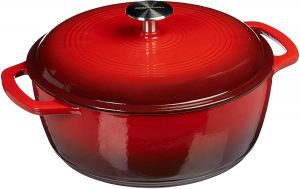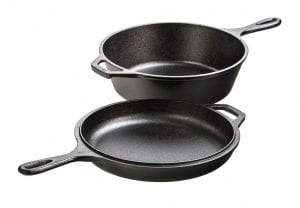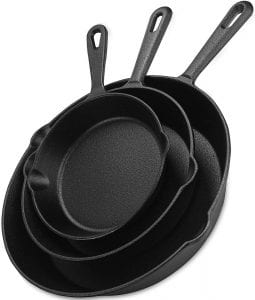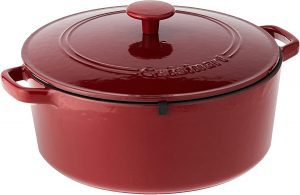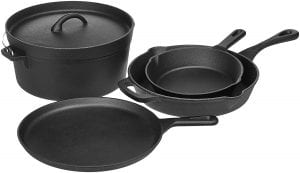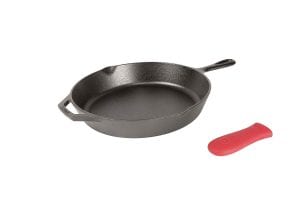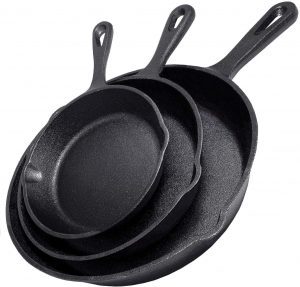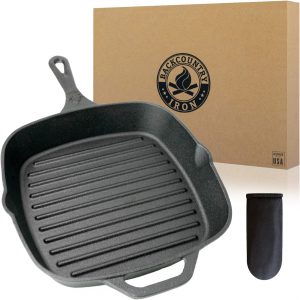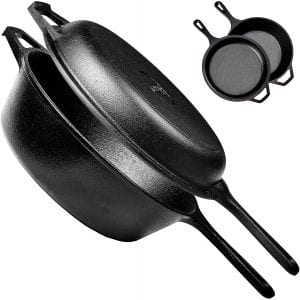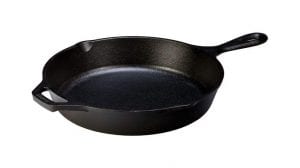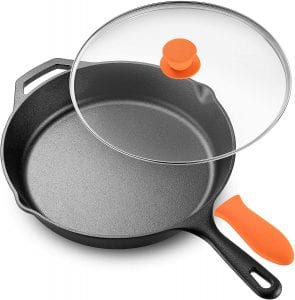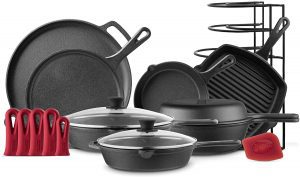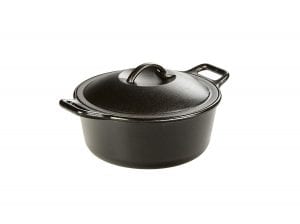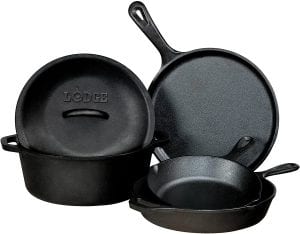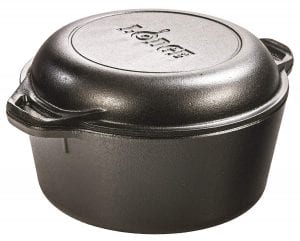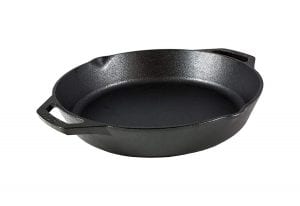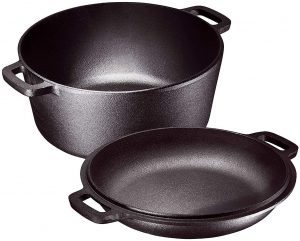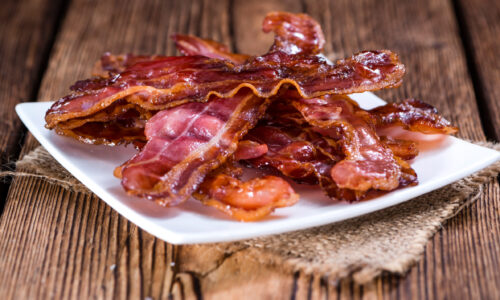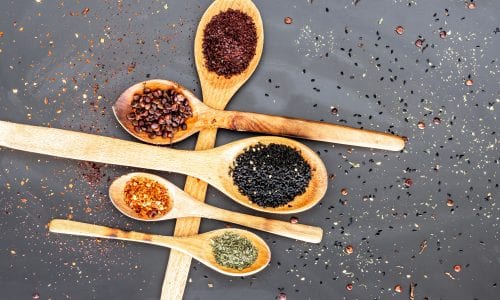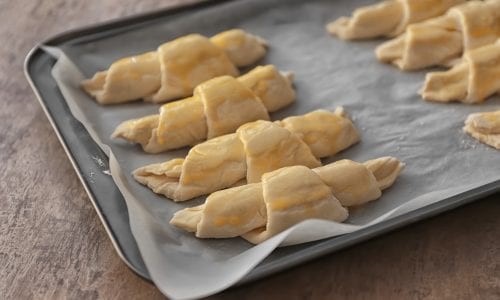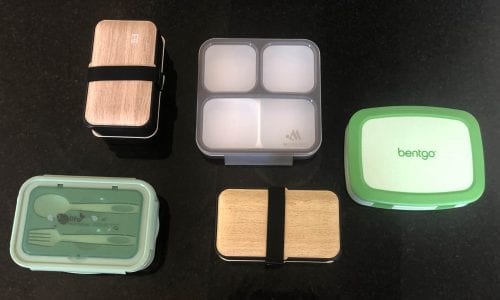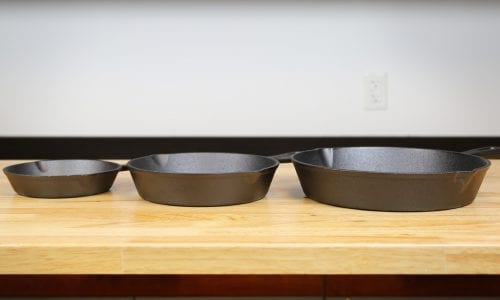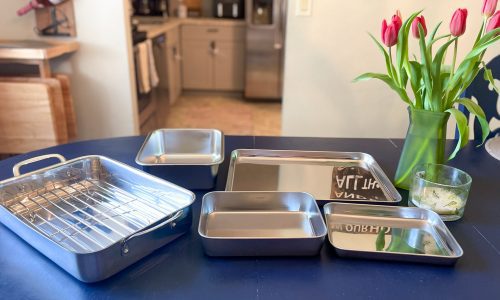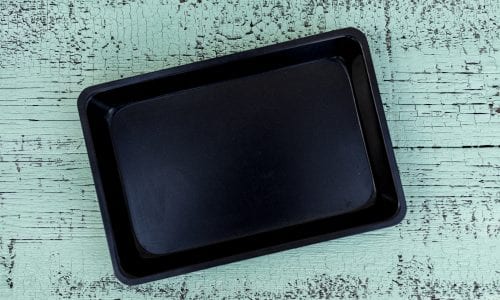The Best Cast Iron Cookware
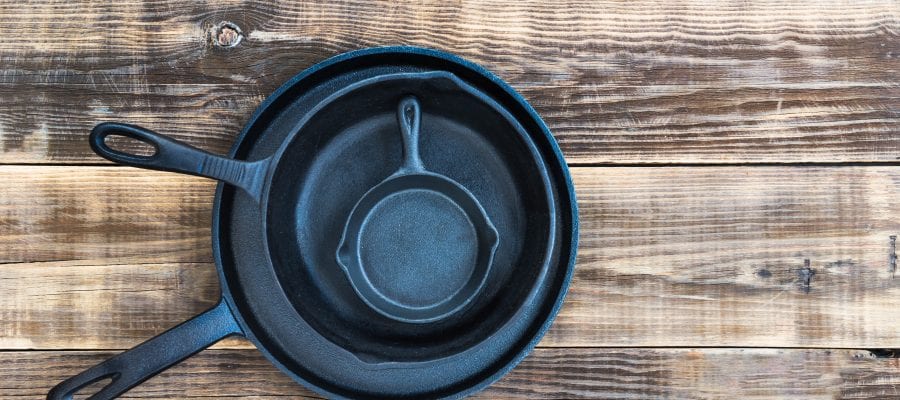
Our Review Process
Don't Waste Your Money is focused on helping you make the best purchasing decision. Our team of experts spends hundreds of hours analyzing, testing, and researching products so you don't have to. Learn more.
Our Picks For The Top Cast Iron Cookware
- 1. AmazonBasics Oven Safe Cast Iron Cookware, 7.3-Quart
- 2. Lodge Cast Iron Combo Cookware, 3.2 Qt
- 3. Utopia Kitchen Pre-Seasoned 3-Piece Cast Iron Cookware, 3-Piece
- 4. Cuisinart Chef’s Classic Enameled Cast Iron Cookware Dutch Oven
- 5. AmazonBasics Pre-Seasoned Cast Iron 5-Piece Set
- 6. Lodge Cast Iron Skillet, 12-inch
- 7. Simple Chef Cast Iron Skillet, 3-Piece Set
- 8. Backcountry Pour Spouts Cast Iron Grill Cookware, 8-Inch
- 9. Cuisinel Pre-Seasoned 3-Quart Dutch Oven Cast Iron Cookware
- 10. Lodge Cast Iron Skillet, 10.25-Inch
- 11. Legend Pre-Seasoned Cast Iron Skillet & Lid
- 12. Cuisinel Glass Lids Cast Iron Pots & Pans Set, 8-Piece
- 13. Lodge Pro-Logic Cast Iron Dutch Oven, 4 Qt
- 14. Lodge Seasoned Cast Iron 5 Piece Bundle
- 15. Lodge Cast Iron Dutch Oven, 5 Qt
- 16. Lodge Cast Iron Dual Handle Pan, 12-Inch
- 17. Bruntmor Pre-Seasoned Cast Iron Double Dutch Oven
This cast iron cookware comes in four colors and three sizes, all at an affordable price. It's great for baking, roasting, braising and other uses in your kitchen.
Affordable ChoiceThis cast iron cookware is perfect for any kitchen, with three size options and multiple color choices.
This set offers great value as it gives you the option of using a shallow frying pan or a deeper skillet to suit the needs of your meal. The deeper 3-quart pot has the potential to make larger volumes of food, such as gravy, or it can hold homemade biscuits as they bake in the oven. The shallow pan will make frying and browning things a breeze.
Versatile ValueThis cast iron cookware won't break the bank and is super versatile.
You won't have to worry about food sticking to this cast iron cookware set, as it comes seasoned with a soy-based oil. There are also several benefits to using cast iron cookware over other types. Cast iron actually leaks iron into your foods, which is especially nice if your body is low on iron. It also distributes heat evenly across the pan.
Low-Maintenance ChoiceThis cast iron cookware set comes with 6-, 8- and 10-inch skillets to prepare everything from eggs for two to a casserole for a family of four.
This cast iron cookware holds 7 quarts and will easily feed a crowd. Despite its size, heat distribution is still great, so you're sure to get an evenly cooked meal, each and every time. Stirring can help prevent food from getting stuck to the bottom and sides of this deep pot, so it may require a little extra attention while cooking to save yourse...
Large CapacityThanks to this cast iron cookware's porcelain enamel interior, you won't have to worry about the oven retaining unwanted flavors or odors.
Buying Guide
When you find yourself needing a new pot or pan to step up your cooking game, the best cookware options in your favorite store will offer quite a number of potential solutions. There are white ceramic pans or thin pans that heat up instantly and claim to dissipate your heat perfectly for your needs. But keep browsing this pan selection and you’ll end up staring at a section of heavy-duty black pots and pans that you swear you’ve seen at your grandparent’s house before. Cast iron cookware is one of the most loved and longest-standing nonstick cooking options that exist. There are numerous reasons why they are regarded so highly, so we will break down some of the key points for you and help guide you towards the best style for your needs.
“There’s a good reason that these pans have been around so long — they work beautifully,” says our resident culinary expert Julie Chernoff, member of Les Dames d’Escoffier, dining editor of Better magazine and food journalist. “They are heavy enough to heat evenly and retain heat, they’re reasonably priced, and they are virtually indestructible.”
The construction of cast iron cookware is very sturdy as it is made as one solid piece of the metal and generally has no other material bolted onto it. Pick one up, and you’ll notice it’s heavier than most other pans due to this thick iron makeup. The thickness of the iron captures the heat coming from the flame or stovetop and slowly passes it on o the other side where the food is. If you were to place a thick skillet on the stove, crank the heat up to high and place a couple of eggs into the pan, the pan would slowly heat up and start firming the egg whites — but without burning them, as would likely happen in a thinner pan. That’s because the cast iron makeup is much more efficient with using and retaining heat.
If a skillet is too shallow for the big pot of chili you might be making for an autumn tailgate, try using something with more depth. Look for one that comes with a lid that helps keep the heat and steam in while the food simmers so all the flavors get to know each other in the pot.
But what about scorching and having food get stuck to the pan? As mentioned above, cast iron really is a non-stick cooking surface — once it is seasoned.
“Look for pre-seasoned pans as a timesaver, because the seasoning process can take a while,” Chernoff says.
All Lodge brand cast iron cookware comes with a coating of 100% vegetable oil on them. This oil is referred to as “seasoning” for cast iron. The oil creates a barrier between your food and the iron and creates a non-stick atmosphere while you’re cooking. The seasoning is a crucial part of getting the best results out of your cast iron cookware.
Cast iron cookware will last for many generations and often gets passed down as a rite of passage to the new cooks in the family. The stories that surround this cookware throughout its lifetime are surely some of the biggest selling points on using cast iron, and it’s something you’ll have to experience for yourself to fully understand. But you still have a big decision to make when you see that there are multiple sizes and shapes of cast iron cookware.
One category is a skillet that is used mainly as a frying pan. It has a deep enough profile to hold a healthy portion of vegetables, rice, pasta or meats that you want to sautee while still being shallow enough to let you get the spatula in for a clean flip on your over-easy eggs. It boasts a multifunctional size and shape that becomes a daily workhorse in most kitchens.
If you’re working on large stews or even roasting whole chickens, a 7-quart Dutch oven holds the largest volume of anything. When filled up with delicious ingredients, it can be the perfect size for feeding large families or meal prepping on Sunday to make the week a little easier for those of us on the go.
As you’re shopping for cast iron cookware, definitely consider the handles.
“Cast iron is heavy, so the handles are especially important, especially in the larger skillets,” Chernoff explains. “One long handle will be unwieldy. Having the ‘helper handle’ opposite the long handle allows the weight to be evenly distributed when carried.”
Cast iron cookware is not dishwasher-safe, so if that is important to you, you’ll want to consider other options. Also, these pots and pans should not air dry, as they may rust. Do not use metal scouring pads on them; once they are cleaned, they should be dried and oiled immediately. Although you must be careful of these elements, cast iron is great for home cooks.
“These pans really are incredibly versatile, from pancakes to deep frying and everything in between, and can easily go from stovetop to oven, as they are safe at almost any temperature,” Chernoff points out. “And unlike non-stick cookware, you can use metal utensils on the surface, as they will not damage it.”
Simply take care of your cast iron cookware, and it’ll perform for you!
Our Expert Consultant

Culinary Expert
Julie Chernoff is a long-time member of Les Dames d’Escoffier (past president of the Chicago Chapter, and current co-chair of the LDEI Legacy Awards Committee), the Association of Food Journalists (AFJ) and the International Association of Culinary Professionals.
Chernoff is the dining editor of Better, a lifestyle website and print magazine. Her journalism started in the test kitchens of Weight Watchers Magazine. She holds a BA in English from Yale University and is a graduate of the California Culinary Academy. She has spent the last few decades styling, photographing, teaching, developing recipes, editing, thinking and writing about food.
What to Look For
- Clean your cast iron cookware with warm water and a fairly rough sponge or brush. There’s no need to use soap when cleaning these pots and pans, and it’s recommended that you do not.
- After you clean all the residue from your cast iron cookware, dry it off and drizzle a little bit of vegetable oil into it before storing it. For convenience, use a paper towel to wipe the vegetable oil all over the surface of the pot or pan to form a light and even coat.
- You now have a properly cleaned and seasoned cast iron pan. Keep up with these two simple tasks each time you use the cookware and you’ll be able to use this non-stick cookware for life.
- Cast iron cookware can be used on more than cooktops. Campfires around the country are a place where delicious meals can be made and eaten under the open sky. Cast iron cookware can be placed directly into an open fire, set on a cooking-rack above the heat and even hung from a tripod so it dangles over the flame. Either way, the heat of the direct flames is tempered down by the thickness of the iron. It allows the camp chef to make meals equally as good as they would in their home.
- Ovens and cast iron also work beautifully together. Make a homemade pizza, and bake it in your cast iron skillet for a deep-dish style pan pizza. Fill your cast iron Dutch oven with a good recipe, where anything from pasta dishes to whole chickens can be oven roasted.
- Lastly, you might find yourself in love with how beautiful this cast iron cookware can be. Share that beauty with your guests by hanging them up in your kitchen for all to see. This can add a rustic farmhouse feel while still being a functional part of your kitchen.
More to Explore
How to clean rusty cast iron cookware
Here are some of the tools you can use and how to use them.
Lodge Rust Eraser
One of the most trusted cast-iron lines out there created its own rust remover — which is good news for the many cooks who own one of their cast-iron skillets. The Lodge Rust Eraser is $9.95 and claims to “remove surface rust and tarnish with precision.” YouTube reviewer Stephen Strawn of Cast Iron Cookware demonstrated the eraser in a video, showing how it has a bit of a rubbery flex to it.
The eraser takes away rust down to the cast-iron surface, which will need to be re-seasoned afterward. Strawn said he thinks the Lodge rust eraser is best for spot removal of rust rather than trying to do the entire surface of a rusty cast-iron item.
Also, speaking of erasers: Magic Erasers can also help with spot-removal of rust on cast iron.
Vinegar
Strawn and many others recommend using vinegar to easily remove rust from a cast-iron skillet, grill, pot or dutch oven. Strawn has a vinegar-water spray bottle method.
Bon Appétit explains that soaking a rusty cast-iron skillet in equal parts vinegar and water and then watching the pan to make sure it’s removed as soon as the rust starts to flake away is the way to go. Soaking cast iron in vinegar for too long will start pitting the surface and make it worse.
Steel Wool
Experts say you should not use steel wool in the normal course of cleaning your cast iron pan, as it’s too harsh. However, in cases of rust or abrasion, steel wool and soap can be used to scrub away the rust and get down to a new base level of the cast iron. Some steel wool pads like Brillo and S.O.S come with soap already in them.
Good arm strength and patience can be needed to get a really rusty cast-iron item smooth again, and you’ll have to season your cast-iron skillet again afterward.
Chainmail
Yes, the thing that knights wore as body armor, chainmail, is also a favored tool for getting tough gunk off cast iron, including rust. Chainmail scrubbers are apparently pretty indestructible, so you won’t need to buy them as often as steel wool — which is good because they are also more expensive.
A Potato And Salt
If you’re wondering if there’s a more “au natural” way to clean a rusty cast-iron skillet, you might wan to try the potato and coarse salt method. Sprinkle a cast iron pan with a generous amount of kosher or other coarse salt. Then cut a raw potato in half and use it as a scrubbing tool to work the salt around the pan and rub off rust.
Oven Cleaner
A decidedly less “natural” way to clean rusty cast-iron skillets and the like is to spray them with oven cleaner. The lye-based cleaner is harsh and needs to be handled with care (and gloves on) while not being inhaled. Letting the cleaner sit and do its work on cast iron may take a few rounds, as a Kitchn tester found.
It’ll also likely remove most of the seasoning from cast iron, so you’ll have some extra re-seasoning to do afterward. Make sure to thoroughly wash the rust-free cast iron with soap and water after using oven cleaner, since it is toxic.
Sandblaster
Not everybody has a sandblaster, but if you can access one, it’s a quick way to remove rust from cast iron. An expert at What’s Cooking America advises that, if you’re going this route, glass beads are less harsh than sand in a blaster. Sandpaper is another good scrubber to get at rust spots but will require more elbow grease.
Electrolysis
Is it magic or science? Reading about electrolysis on cast iron will bring you back to high school science. You’ll need a large plastic bucket, a battery charger, washing soda, and an “anode” like a grill top. Proceed with caution and follow the tips that Weber Kettle Club gives in this post on the process.
Burn It Off
You can burn rust off from cast iron though it will need some follow-up scrubbing to remove residue. If you don’t have a fire going, you can also use the self-clean cycle of your oven.
If you want to see a bunch of different methods used to remove rust from cast iron, YouTuber BushcraftOnFire uses foil as a scrubber for a pan that was kept outside for years. She also wipes it with a newspaper, soaks the pan in vinegar, and sprays on oven cleaner. Then, she seasons it with vegetable shortening.
Re-season Your Cast Iron
After thoroughly removing the rust from inside, outside and on the handle of a cast-iron skillet or pot, you need to re-coat it with oil and season it by baking the newly oiled pan in the oven. Oils with a high smoke point are the best for this; many prefer grapeseed oil for this job.
Other oils you can use for this purpose include almond, avocado, canola, corn, peanut, safflower, sesame and sunflower. Lard and oil bars are also good. You may want to repeat the seasoning process a few times depending on how much of the original coating is left after the rust removal process.
How to prevent rust on cast iron
To avoid rust forming on your cast iron in the future, don’t cook acidic foods and liquids like tomatoes or wine in your cast-iron pots and pans. Clean them only with kosher salt and a cloth or water and a non-abrasive scrub brush.
Make sure you thoroughly dry the cast iron, top and bottom, and then brush or rub on a new coat of oil all over, including on the handle. Put a paper towel on the top and bottom of your cast-iron skillet before storing it with other pans to protect the surface.
And remember that with all these techniques to remove rust, almost any cast iron skillet, pot or oven can be saved — unless you can see through the bottom of them.
by Anna Weaver

